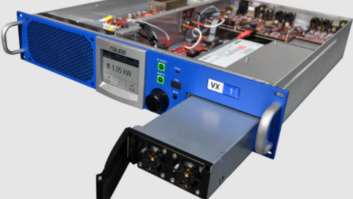Engineer Mike Vanhooser sent in a note about a story we featured a year and a half ago, regarding covering your AM base pier copper strap with roofing tar to discourage copper theft. Mike writes, “Been there, done that, and the copper was still stolen!” Apparently all a thief has to do is soak the cut strap in gasoline or diesel fuel for a day, and the copper comes out clean of any tar.

Fig. 1:A close up of the zener and current limiting resistor, attached to the LED leads.(100-1471) But, Mike adds, it’s still a good idea, since it covers up that glistening shiny copper. The technique is certainly not a foolproof deterrent. Even engraving the copper with the call letters from one end to the other didn’t help. It was still stolen. Mike’s solution was to cover the strap in concrete.
He does that now for the base straps, as well as any strap/coax/wiring in trenches. Now, it’s all now covered in concrete, which makes it just about impossible to steal. Yes, I suppose so, but if you ever have to repair or replace anything in that trench, better bring a jackhammer.
Head to our Radio World links page for this issue, https://www.radioworld.com/July-18-2012, for a link to the original story showing how to cover the pier (and strap) with tar. Mike Vanhooser can be reached at [email protected].
* * *
We’re in the middle of another remote season, and Charles “Buc” Fitch, P. E., has a neat modification to add a squelch “open” light to an older — but still functioning — Moseley RPL Series RPU. Buc writes that this is vintage gear from Moseley, and he considers it to be the Mercedes-Benz of broadcast gear.

Fig. 2:Inside the Moseley RPU, showing the overall modifications (100-68) This squelch-open modification is simple: The Moseley operates a relay, which sends received audio to the back panel of the receiver. The twist here is that when the signal that drives the relay is off, this does not drop the voltage to zero (or at least not to a value under the illumination voltage of the LED — 1.4 volts or so).
Buc chose a yellow LED (Digi-Key L10007 — a little more than $1) to contrast with the red “on” front-panel LED. This L10007 LED pressure-mounts in a ¼-inch hole and is well anchored after pushing the LED into this diameter hole. The LED is encapsulated and has leads that are about 6 inches long, which makes wiring convenient. Buc put the zener in the positive lead (anode towards the +/red lead of the LED) and a 470 ohm, 1/2 watt current limiting/voltage drop resistor in the negative lead seen in Fig. 1.
The easiest place to pick up the voltage on the relay coil was at the back EMF diode, which is across the coil. Referring to Fig. 2, you can see the LED mounted to the right side of the photo, with its red and white leads running to the left of the chassis. The red wire is the positive lead on the diode.
The shielded audio lead coming from the cast metal enclosure, seen at the top of the photograph, houses the last IF and demodulator circuitry. It provides a tap on the signal level point. This is an analog voltage between about 20 — 185 uV of input level of the incoming signal. It is connected to one of the remote control telemetry channels.

Fig. 3:The front panel showing the completed modification(100-1465) Running this signal to your remote control is a big help when aligning the remote antenna. Having access to the signal strength at the remote pickup point allows the remote crew to zero in on the best alignment of the outgoing beam antenna. It eliminates guesswork.
The site where Buc’s modified receiver is located even has a switchable attenuator to extend the range of the input signal reading to 300 uV for even more careful alignment. The front panel of the completed mod can be seen in Fig. 3. Thanks Buc, for what’s sure to be a great afternoon of fun! Buc Fitch can be reached at [email protected].
Contribute to Workbench! You’ll help your fellow engineers, and qualify for SBE recertification credit. Send Workbench tips to [email protected]. Fax to (603) 472-4944.
Author John Bisset has spent 43 years in the broadcasting industry, and is still learning! He is SBE Certified, and is a past recipient of the SBE’s Educator of the Year Award. John just joined Elenos USA, an FM Transmitter Company based in Miami.












